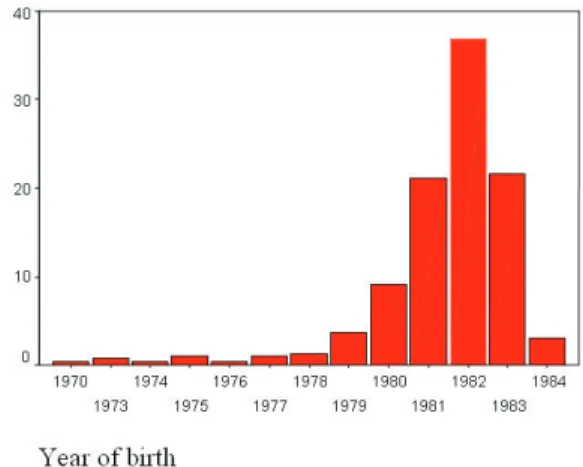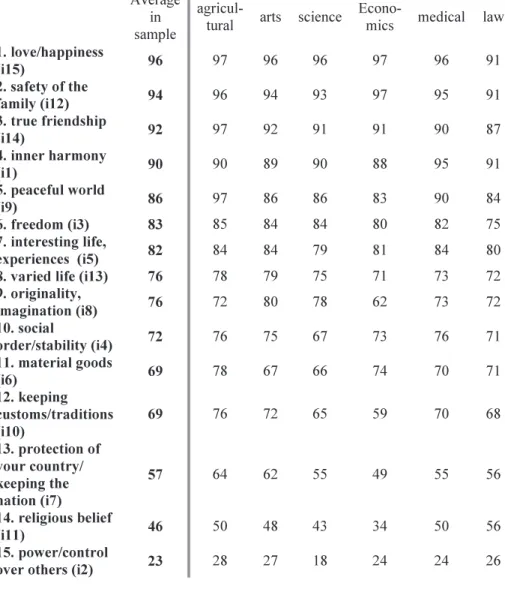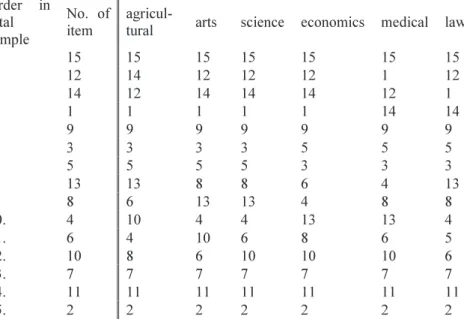ISTVÁN PACSUTA
THE STUDY OF VALUE AMONG STUDENTS OF DEBRECEN UNIVERSITY
Introduction
In my short essay I would like to give a short theoretical and conceptual definition of “value”, moreover, I present the first steps of a larger survey. I briefly refer to authors who have established the theoretical foundation of value studies, mentioning the surveys belonging to their theories. Regarding the extent of this work, the review offered here is not complete, and it requires further elaboration, just like the data collected by the Regional University Researchers. The present work aims to explain the “choice of values” of students at Debrecen University in different faculties.
The importance of defining value
Studying “value” is an important field of research in our century, not only in philosophy, psychology and in social studies, but in other fields of life, as well. As a consequence of rapid technical and social changes, we can also experience a continuous change of values, and changes in the “scale of values”; a repugnance as well as a crisis of values appears; moreover, there is a general uncertainty concerning values.
The numerous varieties of values in real life, in our everyday economic, political and moral behaviour are one reason that the concept needs to be defined as properly as possible. It seems to be a complicated task, because there is a big gap between the abstract philosophical conception of values and the result of empirical research conducted in the specialised sciences.
Similarly, there are big differences among approaches to value research. We just have to think of the works of H. Znanieczki, M. Mead, G.W. Allport or M. Rokeach. We need a common point of view on what we mean by value, and in what ways we can examine the forming and the predominance of social and personal values. In scientific theories, the conception of value appears in two easily separable ways. The first theory says that we choose between the selected or refused object or state; according to the other theory
it is the principle itself by which we choose from objects, people, and phenomena (Szilágyi 2001).
The conceptual definition of value
The concept of value is an abstraction, it cannot be separated from objects, people, or other aspects of life. In the sociological encyclopaedia, the following short definition can be found: “values are general principles, essential orientations, and at the beginning they are collective preferences and the expressions of beliefs” (Bondon-Besnord 1999:52).
According to Ágnes Heller, the “concept of value” is the type of abstraction which appears when the concept of quality emerges; and it distinguishes the desirable from non-desirable, the favourable from non- favourable, the exemplary from fatal, and the evaluation is the common denominator of processes which are about the choice between good and bad.
In the Hungarian literature, the most frequently quoted definition can be read in Váriné Ibolya Szabó’s comprehensive work: “Values – as general motives fixating in abstract, cognitive structures – set the importance of a whole range of things, events, situations, and they endow the events and participants of a situation with significance (valency), or deprive these things of their possible significance. In this way they take part in the construction of social reality that is realised as existence”(Váriné 1987:69-70).
We simply can say that there are two basic ways of interpreting values:
one says that the individual holds a kind of value (subjective approach), while the other states that a thing holds a value (objective approach).
A further characteristic of values is that they depend on the ideology of a particular culture. That is why values can be considered society- and culture- specific conceptual objectifications.
The accurate definition of value also requires a clarification of the difference between values and customs, attitudes, opinions or taste.
Although in these phenomena we can also find the means of “value- creation”, it may have other reasons and they do not necessarily mean value orientation (Szilágyi 2001). Several researchers, including Milton Rokeach, pointed at the fact that people have many attitudes, opinions, but their self- identity is expressed by identification with only a few central values. The more central a value is for an individual or a group, the more likely they are to identify with the value concerned.
Concerning the organisation of values, we need to mention two related elements: the normative function and action-centeredness. The normative function shows the co-ordination of social fitting-in and conformity; action-
centeredness signifies how values as notional objectifications influence and control human action.
The sociological concept of value
Scientific sociology has used the concept of value in a sense closest to philosophy. Max Weber (Weber 1998) introduced the “concept of value”
into sociology. His requirement that science should be free of values and that fact-finding must be separated from evaluation can be considered the foundation-stone of sociological attitude.
According to Weber, value is non-recurring and lawless, an importance projected by people arbitrarily or irrationally. It determines our actions, but it cannot be deduced from our actions, therefore sociology has to deal with the subjective conditions of the doer; and it has to know the purpose-images and value-images related to actions. To examine this, Weber introduced the concepts of purpose-rational and value-rational action. Durkheim also mentions value with a philosophical bias, primarily concerning moral awareness. To Talcott Parsons this is the category of conscience collective, a system of convictions, so the system of values. Value appears as the synonym of moral standard. Value, as Durkheim sees it, is not only of purpose in nature, but at the same time it is a product of nature, and it can be considered a social objectification (Parsons-Skils 1951).
There is another well-known and often used philosophical, linear value- typological model, worked out by C. Kluckhohn, which separates three different groups in the world of values. In the first group, we can find values concerning the relationship between man and nature; the second group contains the relationship between man and man, and the third group contains together man-nature and man-man relationships. The value-typology established by C. Kluckhohn has been applied in intercultural research (Váriné 1987).
C. Kluckhohn’s concept of value: “Value is the concept of the desirable explicit or implicit, which is distinctive to the individual or it is characteristic of the group, and influences how we choose the ways, means and aims of actions” (Váriné 1987).
He emphasizes three dimensions of values:
a, the dimension of modality: whether the value is attractive or repulsing b, the dimension of meaning: used for representing quality
c, the dimension of intention: means the preferred way of behaviour
Talcott Parsons regarded values as established role-expectations, so values are behaviour patterns and rules that are formed together.
His value-oriented typifying scheme prevails in the following dichotomies:
– driven by emotions—emotionally neutral – self-oriented—community-oriented – universal—particular
– compulsory (rule or norm)—achievement-like
He thinks that this can be applied to give a static, descriptive characterisation of any culture. Moreover, he wants to meet the requirement that by his value dimensions in every culture there is a base-person who belongs to that culture and holds the essence of that particular culture (Parsons-Skils 1951).
The results of the research
In this study I discuss the data we got by a questionnaire survey, which was conducted by the Regional Research Group of the Institute of Education at Debrecen University. The survey was carried out among students of Debrecen University. This is just a small part of a larger work to be completed in future, which uses the entire database of the research group.
Total number N=394, women: 260, men: 132, all of them students at Debrecen University
The combination of faculties is as follows:
Table 1 Faculty * gender of questioned
boy girl
agricultural 16 43 59
arts 23 69 93
sciences 67 75 142
economics 14 17 31
medical 8 36 45
law 4 20 24
Minimum age 21, maximum age 35, average 23.5; standard deviance:
1.77. 95% of sample are 21-26 years old. Most students are 24 years old, which amounts to 36.5%.
Figure 1 Year of birth of the students in the sample
This diagram contains the educational level of parents Table 2. Faculty * educational level of father Primary or
less
Trade school.
vocational
Technical school
Secondary
grammar school college university
agricultural 6.8% 22.0% 35.6% 5.1% 18.6% 11.9%
arts 1.1% 22.8% 30.4% 16.3% 14.1% 15.2%
sciences 27.6% 26.9% 4.5% 17.2% 23.9%
economics 3.4% 24.1% 24.1% 10.3% 13.8% 24.1%
medical 17.1% 19.5% 14.6% 12.2% 36.6%
Faculty of
law 4.3% 34.8% 30.4% 30.4%
These percentages are row-percentages, so we have to take the total data of faculties as 100%. It can be seen in the table that at the Faculty of Law the educational level of the father is usually the highest, in the second place we can find the Medical Faculty, in the last place we can find the Agricultural faculty
Table 3 The statistical index of the educational level of the father and the mother (1-maximum primary school, 2-vocational or trade school, 3-technical
school, 4-secondary grammar, 5-college, 6-university)
Father Mother
Median Modus Standard
deviation Median Modus Standard deviation
agricultural 3 3 1.49 4 5 1.33
arts 3 3 1.4 4 5 1.3
sciences 3 2 1.58 4 5 1.39
economics 3 3 1.63 5 5 1.58
medical 4 6 1.56 4 4 1.37
law 5 3 1.38 5 5 1.24
It is interesting that if we take the education of the mother into consideration, we cannot find such big differences. At least in statistical middle values, there are no such strongly marked differences as if we regarded the educational level of the father alone.
It can be very informative if we take educational level as a numerical variable because theoretically there is intensity in it—for example, there are more university qualifications than secondary qualifications. However, as the differences between items cannot be expressed with numbers, theoretically we cannot have an average with these variables. If we still try it, we will get the following result: if we grade the educational levels of the father and the mother separately, we will have the following order:
Education of father: agricultural< arts < economics< science <medical
<law
Education of mother: economics <science <arts <agricultural< medical
<law,
Together (average): agricultural -3.75 < arts -3.84 < economics -3.88<
science -3.91< medical -4.33 < law -4.52
So the parents of both the faculty of law and the faculty of medicine have higher education in all three cases.
Analysis of variables
I transposed the scale of 4 into a scale of 100, so it is easier to represent.
The original and the transposed results are as follows:
1-not important at all=> 0 2-rather not important=> 33.3 3-rather important=> 66.6 4-very important=> 100
Then I averaged and then I put the results into order according to the results of the total sample.
Table 4 Order of different values
In brackets, we can find the number of each item on the list (e.g. item 15 was love and happiness, those who gave answer put this into the first place):
Average in sample
agricul-
tural arts science Econo-
mics medical law 1. love/happiness
(i15) 96 97 96 96 97 96 91
2. safety of the
family (i12) 94 96 94 93 97 95 91
3. true friendship
(i14) 92 97 92 91 91 90 87
4. inner harmony
(i1) 90 90 89 90 88 95 91
5. peaceful world
(i9) 86 97 86 86 83 90 84
6. freedom (i3) 83 85 84 84 80 82 75
7. interesting life,
experiences (i5) 82 84 84 79 81 84 80
8. varied life (i13) 76 78 79 75 71 73 72
9. originality,
imagination (i8) 76 72 80 78 62 73 72
10. social
order/stability (i4) 72 76 75 67 73 76 71
11. material goods
(i6) 69 78 67 66 74 70 71
12. keeping customs/traditions (i10)
69 76 72 65 59 70 68
13. protection of your country/
keeping the nation (i7)
57 64 62 55 49 55 56
14. religious belief
(i11) 46 50 48 43 34 50 56
15. power/control
over others (i2) 23 28 27 18 24 24 26
Table 5 Differences in order, also according to faculties Order in
total sample
No. of item
agricul-
tural arts science economics medical law
1. 15 15 15 15 15 15 15
2. 12 14 12 12 12 1 12
3. 14 12 14 14 14 12 1
4. 1 1 1 1 1 14 14
5. 9 9 9 9 9 9 9
6. 3 3 3 3 5 5 5
7. 5 5 5 5 3 3 3
8. 13 13 8 8 6 4 13
9. 8 6 13 13 4 8 8
10. 4 10 4 4 13 13 4
11. 6 4 10 6 8 6 5
12. 10 8 6 10 10 10 6
13. 7 7 7 7 7 7 7
14. 11 11 11 11 11 11 11
15. 2 2 2 2 2 2 2
So love and happiness (item 15), peaceful world (item 9), protecting and keeping your country and nation (item 7), religious belief (item 11), power and control over others (item 2) are in the same place in all faculties, in other items there is a slight difference. The largest disagreement can be found in the question of freedom (item 6) and originality, imagination (item 8).
Students ranked these values from 1 to 10, according to how important they are for them. The ranking is as follows, according to average results.
Table 6 How important are the following things?
average Medián Standard deviation
1. family 9,49 10 1,26
2. your plans for the future come true 9,04 10 1,30
3. friends 8,50 9 1,61
4. if you are educated 8,38 9 1,76
5. your job/studies 8,37 8 1,39
6. the kind of job you do 8,27 8 1,48
7. free time/entertainment 7,95 8 1,75
8. how important you feel in society 7,42 8 2,23
9. being Hungarian 7,32 8 2,55
7,29 8 1,92
11. culture/learnedness 6,94 7 2,03 12. how much your parents earn 6,68 7 2,24
13. religion/belief 5,04 5 3,25
14. politics, public life 4,12 4 2,33
The most important things for them are family, future plans come true, and friends.
It is a remarkable result that they turn away from politics and public life (4.12 average). Religion had a low average (5.04), so it has a low importance among students asked.
It also turns out that for most students free time is more important than money.
In other parts of the analysis, since we have more than two independent variables, I applied one-way anova. Then I compared them by pairs to find the significant differences at each faculty.
Table 8 The investigation of significance between faculties How important are the following
things? Faculty Sig.
your job/studies agricultural - economics economics - medical
0.028 0.001
friends agricultural - science 0.032
politics, public life agricultural - science arts - science
0.021 0.000
culture/learnedness
agricultural - economics arts - science
arts - economics economics - medical law - medical
0.033 0.030 0.000 0.002 0.014
money agricultural - science
agricultural - arts
0.008 0.000
the kind of job you do
agricultural - science agricultural - economics science - medical economics - medical
0.001 0.013 0.009 0.035 being Hungarian
agricultural - arts agricultural - science agricultural - economics
0.015 0.000 0.031
if you are educated agricultural - science agricultural - economics
0.013 0.019 how important you feel in society
agricultural - economics science - medical economics - medical
0.029 0.036 0.006 your plans for the future come true agricultural - science
agricultural - economics
0.002 0.003
From this chart, I would like to take out only a few significant results. It is interesting that general stereotypes cannot be proved, so the students of medical and law faculties are not more materialistic (these are well-paid jobs), consequently there is no significant statistical difference. For the students at the agricultural faculty, work and studies are significantly more important than for the students of economy. In this sense, the devotion of medical students is the biggest.
The results in the chart above and the differences between the faculties can be explained statistically, but in fact the differences are small.
Consequently, I think that the variable that students go to various faculties, does not give an explanation to the different choices or proves only a small part of it. We can notice that there is no big difference in general values, so in the future other variables should be involved.
I would like to take out some interesting facts. According to the expectations, being important in society is very important at the Medical Faculty. Religion is not important at the faculty of Economics but students at the Medical Faculty were the most religious. These faculties do not provide any explanatory force. There is no big difference in general values, later other explanatory variables should be involved.
Works cited and consulted
Bondon Raymond and Besnord Philippe (1999). Szociológiai lexikon (Encyclopedia of sociology). Corvina, Budapest.
Csepeli György (1997). Szociálpszichológia (Social psychology). Osiris Kiadó, Budapest.
F.Kluckhohn and F.L.Strodtbeck (1961).Variation in value orientation. Evanston.
G. H. Mead (1980). A pszichikum, az én és a társadalom (The Psyche, the self and Society). Gondolat, Budapest.
Heller Ágnes (1970). A szándéktól a következményig (From intention to consequence). Magvető, Budapest.
Max Weber (1998). Tanulmányok (Studies). Osiris, Budapest
Somogyi Zoltán (1984). Az erkölcsi értékek világa (The world of moral values).
Magvető Budapest.
Szilágyi István (2001). Magyar, román és belga szociális szakos hallgatók összehasonlító érték- és attitűdvizsgálata (Hungarian, Romanian, Belgian social study students’ comparative value and attitude study). PhD dissertation. Debrecen.
Szilvási László (2005). Szervezetszociológia (Organisation sociology). Eger.
T.Parsons and E.Skils (1951). Toward a general theory of action. Harvard.
Váriné Szilágyi Ibolya (1987). Az ember, a világ és az értékek világa (Man, world and the world of values). Gondolat, Budapest.
William I. Thomas and Florian Znaniecki (2002). A lengyel paraszt Európában és Amerikában (The Polish farmer in Europe and in the USA.). Új Mandátum, Budapest.




